Face (geometry)
Insolid geometry,afaceis a flatsurface(aplanarregion) that forms part of the boundary of a solid object;[1]a three-dimensional solid bounded exclusively by faces is apolyhedron.
In more technical treatments of the geometry of polyhedra and higher-dimensionalpolytopes,the term is also used to mean an element of any dimension of a more general polytope (in any number of dimensions).[2]
Polygonal face
[edit]In elementary geometry, afaceis apolygon[note 1]on the boundary of apolyhedron.[2][3]Other names for a polygonal face includepolyhedron sideand Euclidean planetile.
For example, any of the sixsquaresthat bound acubeis a face of the cube. Sometimes "face" is also used to refer to the 2-dimensional features of a4-polytope.With this meaning, the 4-dimensionaltesseracthas 24 square faces, each sharing two of 8cubiccells.
| Polyhedron | Star polyhedron | Euclidean tiling | Hyperbolic tiling | 4-polytope |
|---|---|---|---|---|
| {4,3} | {5/2,5} | {4,4} | {4,5} | {4,3,3} |
 Thecubehas 3 squarefacesper vertex. |
 Thesmall stellated dodecahedronhas 5pentagrammicfaces per vertex. |
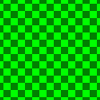 Thesquare tilingin the Euclidean plane has 4 squarefacesper vertex. |
 Theorder-5 square tilinghas 5 squarefacesper vertex. |
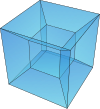 Thetesseracthas 3 squarefacesper edge. |
Number of polygonal faces of a polyhedron
[edit]Anyconvex polyhedron's surface hasEuler characteristic
whereVis the number ofvertices,Eis the number ofedges,andFis the number of faces. This equation is known asEuler's polyhedron formula.Thus the number of faces is 2 more than the excess of the number of edges over the number of vertices. For example, acubehas 12 edges and 8 vertices, and hence 6 faces.
k-face
[edit]In higher-dimensional geometry, the faces of apolytopeare features of all dimensions.[2][4][5]A face of dimensionkis called ak-face. For example, the polygonal faces of an ordinary polyhedron are 2-faces. Inset theory,the set of faces of a polytope includes the polytope itself and the empty set, where the empty set is for consistency given a "dimension" of −1. For anyn-polytope (n-dimensional polytope),−1 ≤k≤n.
For example, with this meaning, the faces of acubecomprise the cube itself (3-face), its (square)facets(2-faces), its (line segment) edges (1-faces), its (point) vertices (0-faces), and the empty set.
In some areas of mathematics, such aspolyhedral combinatorics,a polytope is by definition convex. Formally, a face of a polytopePis the intersection ofPwith anyclosedhalfspacewhose boundary is disjoint from the interior ofP.[6]From this definition it follows that the set of faces of a polytope includes the polytope itself and the empty set.[4][5]
In other areas of mathematics, such as the theories ofabstract polytopesandstar polytopes,the requirement for convexity is relaxed. Abstract theory still requires that the set of faces include the polytope itself and the empty set.
Ann-dimensionalsimplex(line segment (n= 1), triangle (n= 2), tetrahedron (n= 3), etc.), defined byn+ 1vertices, has a face for each subset of the vertices, from the empty set up through the set of all vertices. In particular, there are2n+ 1faces in total. The number of them that arek-faces, fork∈ {−1, 0,...,n},is thebinomial coefficient.
There are specific names fork-faces depending on the value ofkand, in some cases, how closekis to the dimensionalitynof the polytope.
Vertex or 0-face
[edit]Vertexis the common name for a 0-face.
Edge or 1-face
[edit]Edgeis the common name for a 1-face.
Face or 2-face
[edit]The use offacein a context where a specifickis meant for ak-face but is not explicitly specified is commonly a 2-face.
Cell or 3-face
[edit]Acellis apolyhedralelement (3-face) of a 4-dimensional polytope or 3-dimensional tessellation, or higher. Cells arefacetsfor 4-polytopes and 3-honeycombs.
Examples:
| 4-polytopes | 3-honeycombs | ||
|---|---|---|---|
| {4,3,3} | {5,3,3} | {4,3,4} | {5,3,4} |
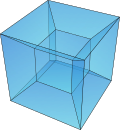 Thetesseracthas 3 cubic cells (3-faces) per edge. |
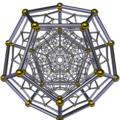 The120-cellhas 3dodecahedralcells (3-faces) per edge. |
 Thecubic honeycombfills Euclidean 3-space with cubes, with 4 cells (3-faces) per edge. |
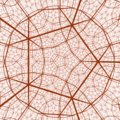 Theorder-4 dodecahedral honeycombfills 3-dimensional hyperbolic space with dodecahedra, 4 cells (3-faces) per edge. |
Facet or (n− 1)-face
[edit]In higher-dimensional geometry, thefacets(also calledhyperfaces)[7]of an-polytope are the (n− 1)-faces (faces of dimension one less than the polytope itself).[8]A polytope is bounded by its facets.
For example:
- The facets of aline segmentare its 0-faces orvertices.
- The facets of apolygonare its 1-faces oredges.
- The facets of apolyhedronor planetilingare its2-faces.
- The facets of a4D polytopeor3-honeycombare its3-facesor cells.
- The facets of a5D polytopeor 4-honeycomb are its4-faces.
Ridge or (n− 2)-face
[edit]In related terminology, the (n− 2)-faces of ann-polytope are calledridges(alsosubfacets).[9]A ridge is seen as the boundary between exactly two facets of a polytope or honeycomb.
For example:
- The ridges of a 2Dpolygonor 1D tiling are its 0-faces orvertices.
- The ridges of a 3Dpolyhedronor planetilingare its 1-faces oredges.
- The ridges of a4D polytopeor3-honeycombare its 2-faces or simplyfaces.
- The ridges of a5D polytopeor 4-honeycomb are its 3-faces orcells.
Peak or (n− 3)-face
[edit]The (n− 3)-faces of ann-polytope are calledpeaks.A peak contains a rotational axis of facets and ridges in a regular polytope or honeycomb.
For example:
- The peaks of a 3Dpolyhedronor planetilingare its 0-faces orvertices.
- The peaks of a4D polytopeor3-honeycombare its 1-faces oredges.
- The peaks of a5D polytopeor 4-honeycomb are its 2-faces or simplyfaces.
See also
[edit]Notes
[edit]- ^Some other polygons, which are not faces, are also important for polyhedra and tilings. These includePetrie polygons,vertex figuresandfacets(flat polygons formed by coplanar vertices that do not lie in the same face of the polyhedron).
References
[edit]- ^Merriam-Webster's Collegiate Dictionary(Eleventh ed.). Springfield, MA:Merriam-Webster.2004.
- ^abcMatoušek, Jiří(2002),Lectures in Discrete Geometry,Graduate Texts in Mathematics,vol. 212, Springer, 5.3 Faces of a Convex Polytope, p. 86,ISBN9780387953748.
- ^Cromwell, Peter R. (1999),Polyhedra,Cambridge University Press, p. 13,ISBN9780521664059.
- ^abGrünbaum, Branko(2003),Convex Polytopes,Graduate Texts in Mathematics, vol. 221 (2nd ed.), Springer, p.17.
- ^abZiegler, Günter M.(1995),Lectures on Polytopes,Graduate Texts in Mathematics, vol. 152, Springer, Definition 2.1, p. 51,ISBN9780387943657.
- ^Matoušek (2002)andZiegler (1995)use a slightly different but equivalent definition, which amounts to intersectingPwith either a hyperplane disjoint from the interior ofPor the whole space.
- ^N.W. Johnson:Geometries and Transformations,(2018)ISBN978-1-107-10340-5Chapter 11:Finite symmetry groups,11.1 Polytopes and Honeycombs, p.225
- ^Matoušek (2002),p. 87;Grünbaum (2003),p. 27;Ziegler (1995),p. 17.
- ^Matoušek (2002),p. 87;Ziegler (1995),p. 71.


